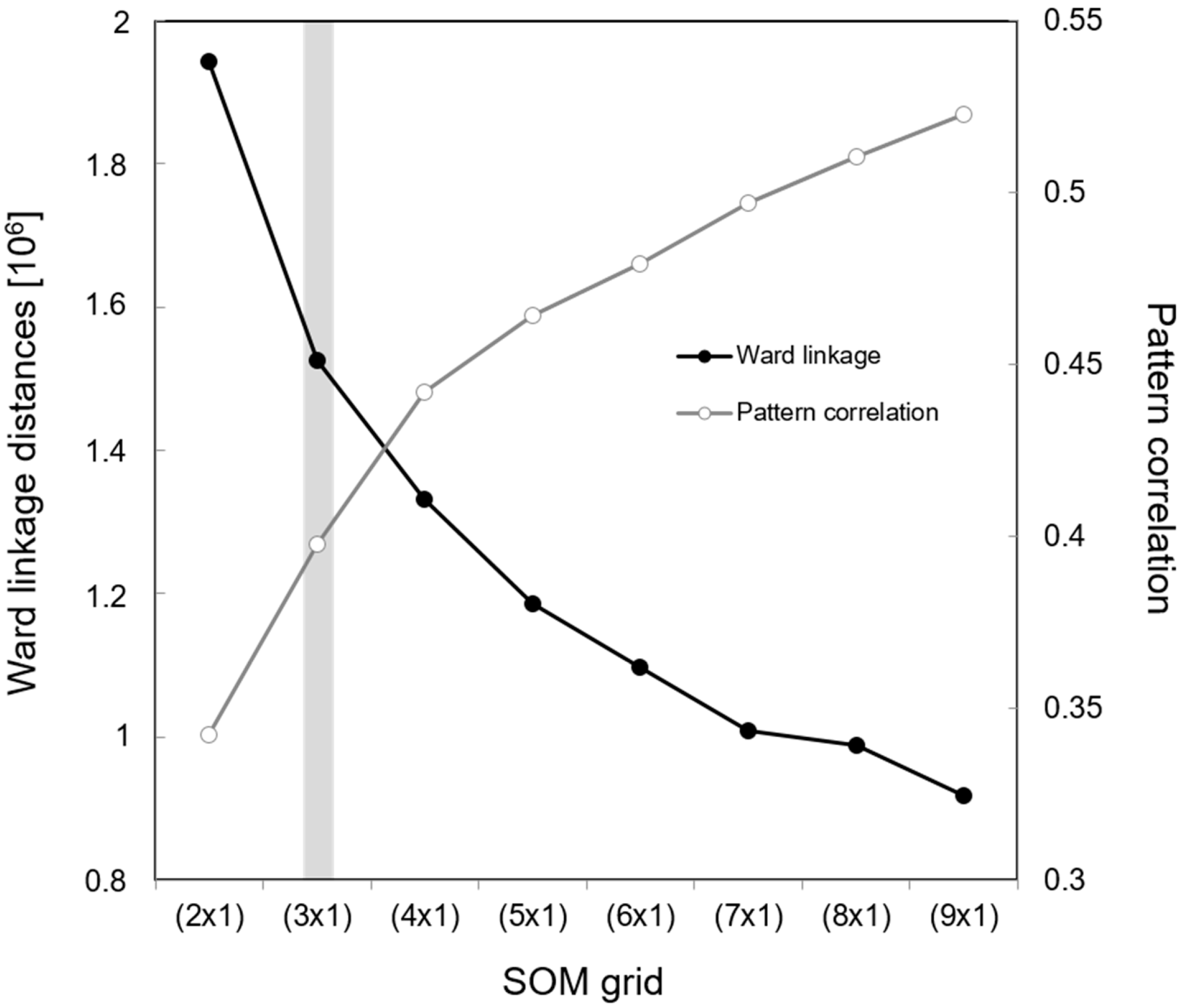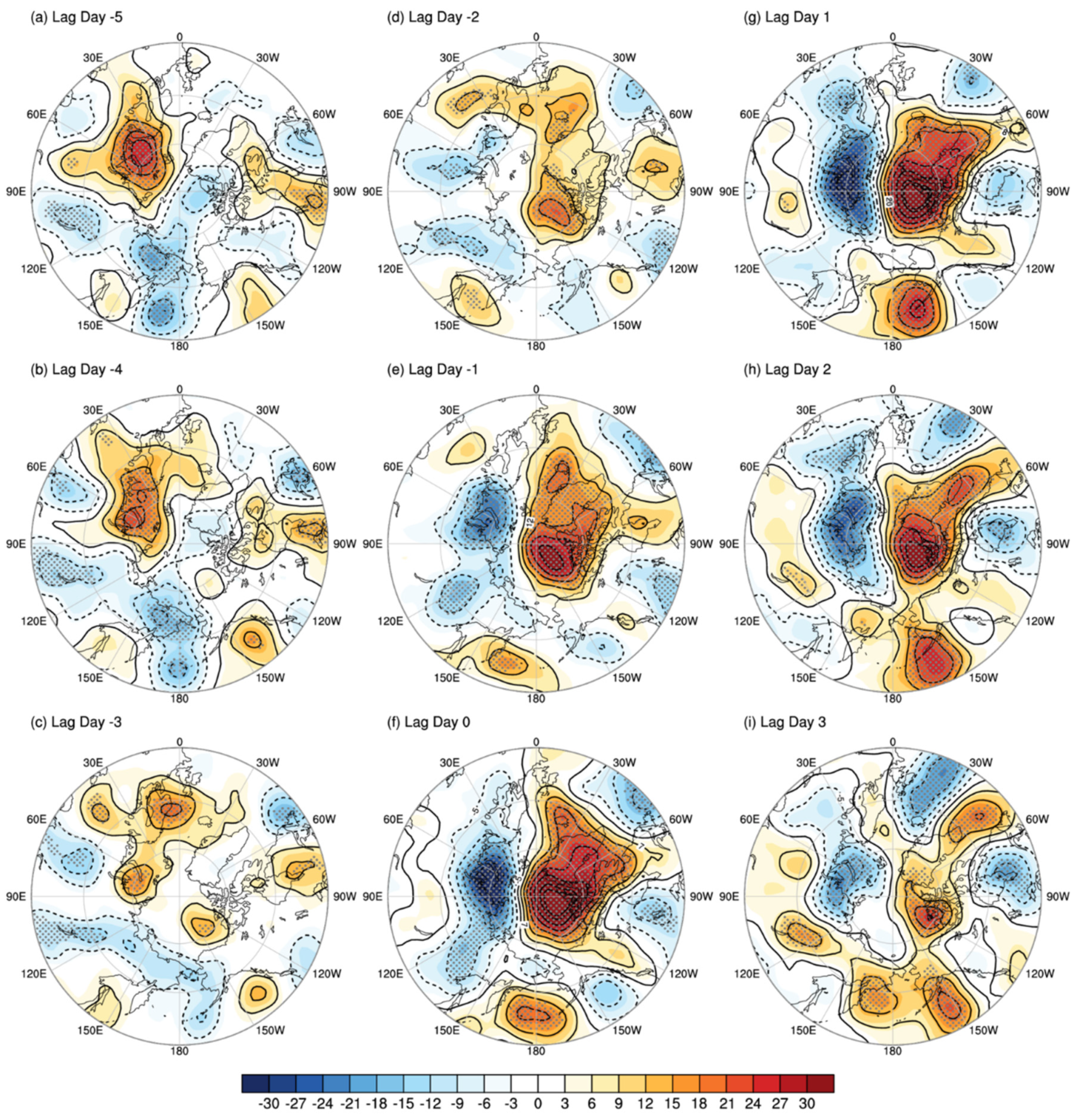The Role of Synoptic Cyclones for the Formation of Arctic Summer Circulation Patterns as Clustered by Self-Organizing Maps
Abstract
:1. Introduction
2. Data and Methods
2.1. Data
2.2. Self-Organizing Maps (SOMs)
2.3. Cyclone Tracking and Gridding
3. Results
3.1. SOM Patterns for the Summer MSLP in the Arctic
3.2. Cyclone Activities Associated with the SOMs
3.3. Large-Scale Fields Relevant to the Cyclone Activity Forming Each SOM
3.4. Synoptic Evolution Associated with the SOMs
4. Discussion and Conclusions
Author Contributions
Funding
Acknowledgments
Conflicts of Interest
References
- Rigor, I.G.; Wallace, J.M.; Colony, R.L. Response of sea-ice to the Arctic oscillation. J. Clim. 2002, 15, 2648–2663. [Google Scholar] [CrossRef]
- Rigor, I.G.; Wallace, J.M. Variations in the age of Arctic sea-ice and summer sea-ice extent. Geophys. Res. Lett. 2004, 31, L09401. [Google Scholar] [CrossRef]
- Wang, J.; Zhang, J.; Watanabe, E.; Ikeda, M.; Mizobata, K.; Walsh, J.E.; Bai, X.; Wu, B. Is the Dipole anomaly a major driver to record lows in Arctic summer sea ice extent? Geophys. Res. Lett. 2009, 35, L05706. [Google Scholar] [CrossRef]
- Ogi, M.; Wallace, J.M. Summer minimum Arctic sea ice extent and the associated summer atmospheric circulation. Geophys. Res. Lett. 2007, 109, D20114. [Google Scholar] [CrossRef]
- Ogi, M.; Yamazaki, K. Trends in the summer northern annular mode and Arctic sea ice. SOLA 2010, 6, 41–44. [Google Scholar] [CrossRef]
- Ogi, M.; Wallace, J.M. The role of summer surface wind anomalies in the summer Arctic sea ice extent in 2010 and 2011. Geophys. Res. Lett. 2012, 39, L09704. [Google Scholar] [CrossRef]
- Screen, J.A.; Simmonds, I.; Keay, K. Dramatic interannual changes of perennial Arctic sea ice linked to abnormal summer storm activity. J. Geophys. Res. 2011, 116, D15105. [Google Scholar] [CrossRef]
- Knudsen, E.M.; Orsolini, Y.J.; Furevik, T.; Hodges, K.I. Observed anomalous atmospheric patterns in summers of unusual Arctic sea ice melt. J. Geophys. Res. 2015, 120, 2595–2611. [Google Scholar] [CrossRef] [Green Version]
- Ding, Q.; Schweiger, A.; L’Heureux, M.; Battisti, D.; Po-Chedley, S.; Johnson, N.; Blanchard-Wrigglesworth, E.; Harnos, K.; Zhang, Q.; Eastman, R.; et al. Influence of high-latitude atmospheric circulation changes on summertime Arctic sea ice. Nat. Clim. Chang. 2017, 7, 289–295. [Google Scholar] [CrossRef]
- Kapsch, M.; Graversen, R.G.; Tjernström, M. Springtime atmospheric energy transport and the control of Arctic summer sea–ice extent. Nat. Clim. Chang. 2013, 3, 744–748. [Google Scholar] [CrossRef]
- Park, H.-S.; Lee, S.; Kosaka, Y.; Son, S.-W.; Kim, S.-W. The impact of Arctic winter infrared radiation on early summer sea ice. J. Clim. 2015, 28, 6281–6296. [Google Scholar] [CrossRef]
- Williams, J.; Tremblay, B.; Newton, R.; Allard, R. Dynamic preconditioning of the minimum September sea-ice extent. J. Clim. 2016, 29, 5879–5891. [Google Scholar] [CrossRef]
- Zhang, X.; Walsh, J.E.; Zhang, J.; Bhatt, U.S.; Ikeda, M. Climatology and interannual variability of Arctic cyclone activity: 1948–2002. J. Clim. 2004, 17, 2300–2317. [Google Scholar] [CrossRef]
- Serreze, M.C.; Barrett, A.P. The summer cyclone maximum over the central Arctic ocean. J. Clim. 2008, 21, 1048–1065. [Google Scholar] [CrossRef]
- Orsolini, Y.J.; Sorteberg, A. Projected changes in Eurasian and Arctic summer cyclones under global warming in the Bergen climate model. Atmos. Ocean. Sci. Lett. 2009, 2, 62–67. [Google Scholar] [CrossRef]
- Crawford, A.D.; Serreze, M.C. A new look at the summer Arctic frontal zone. J. Clim. 2015, 28, 737–754. [Google Scholar] [CrossRef]
- Mesquita, M.; Kvamstø, N.G.; Sorteberg, A.; Atkinson, D.E. Climatological properties of summertime extra-tropical storm track in the Northern Hemisphere. Tellus A. 2008, 60, 557–569. [Google Scholar] [CrossRef]
- Simmonds, I.; Rudeva, I. The great Arctic cyclone of August 2012. Geophys. Res. Lett. 2012, 39, L23709. [Google Scholar] [CrossRef]
- Semenov, A.; Zhang, X.; Rinke, A.; Dorn, W.; Dethloff, K. Arctic intense summer storms and their impacts on sea ice—A regional climate modeling study. Atmosphere 2019, 10, 218. [Google Scholar] [CrossRef]
- Wernli, H.; Papritz, L. Role of polar anticyclones and mid-latitude cyclones for Arctic summertime sea-ice melting. Nat. Geosci. 2018, 11, 108–113. [Google Scholar] [CrossRef]
- Johnson, N.C. How many ENSO flavors can we distinguish? J. Clim. 2013, 26, 4816–4827. [Google Scholar] [CrossRef]
- Lee, S.; Feldstein, S.B. Detecting ozone- and greenhouse gas-driven wind trends with observational data. Science 2013, 339, 563–567. [Google Scholar] [CrossRef]
- Feldstein, S.B.; Lee, S. Intraseasonall and interdecadal jet shift in the Northern Hemisphere: The role of warm pool tropical convection and sea ice. J. Clim. 2014, 27, 6497–6518. [Google Scholar] [CrossRef]
- Reusch, D.B.; Alley, R.B.; Hewitson, B.C. Relative performance of self-organizing maps and principal component analysis in pattern extraction from synthetic climatological data. Polar Geogr. 2005, 29, 188–212. [Google Scholar] [CrossRef]
- Bao, M.; Wallace, J.M. Cluster analysis of Northern Hemisphere wintertime 500-hPa flow regimes during 1920–2014. J. Atmos. Sci. 2015, 72, 3597–3608. [Google Scholar] [CrossRef]
- Lee, M.-H.; Lee, S.; Song, H.-J.; Ho, C.-H. The recent increase in the occurrence of a boreal summer teleconnection and its relationship with temperature extremes. J. Clim. 2017, 30, 7493–7504. [Google Scholar] [CrossRef]
- Dee, D.P.; Uppala, S.M.; Simmons, A.J.; Berrisford, P.; Poli, P.; Kobayashi, S.; Andrae, U.; Balmaseda, M.A.; Balsamo, G.; Bauer, P.; et al. The ERA-Interim reanalysis: Configuration and performance of the data assimilation system. Quart. J. R. Meteorol. Soc. 2011, 137, 553–597. [Google Scholar] [CrossRef]
- Johnson, N.C.; Feldstein, S.B.; Tremblay, B. The continuum of Northern Hemisphere teleconnection patterns and a description of the NAO shift with the use of self-organizing maps. J. Clim. 2008, 21, 6354–6371. [Google Scholar] [CrossRef]
- Kohonen, T. Self-Organizing Maps, 3rd ed.; Springer: Berlin, Germany, 2001; p. 521. [Google Scholar]
- Leloup, J.; Lachkar, Z.; Boulaner, J.-P.; Thiria, S. Detecting decadal changes in ENSO using neural networks. Clim. Dyn. 2007, 28, 147–162. [Google Scholar] [CrossRef]
- Xu, G.; Zong, Y.; Yang, Z. Applied Data Mining; CRC Press: Boca Raton, FL, USA, 2013; p. 284. [Google Scholar]
- Hewitson, B.C.; Crane, R.G. Self-organizing maps: Applications to synoptic climatology. Clim. Res. 2002, 22, 13–26. [Google Scholar] [CrossRef]
- Vitart, F.; Anderson, J.L.; Stern, W.F. Simulation of interannual variability of tropical storm frequency in an ensemble of GCM integrations. J. Clim. 1997, 10, 745–760. [Google Scholar] [CrossRef]
- Crawford, A.D.; Serreze, M.C. Does the summer Arctic frontal zone influence Arctic ocean cyclone activity? J. Clim. 2016, 29, 4977–4992. [Google Scholar] [CrossRef]
- Liu, Y.; Weisberg, R.H. A review of self-organizing map applications in meteorology and oceanography. In Self-Organizing Map—Applications and Novel Algorithm Design; Mwasiagi, J.I., Ed.; InTech: Rijeka, Croatia, 2011; pp. 253–272. [Google Scholar]
- Bell, G.D.; Halpert, M.S.; Schnell, R.C.; Higgins, R.W.; Lawrimore, J.; Kousky, V.E.; Tinker, R.; Thiaw, W.; Chelliah, M.; Artusa, A. Climate assessment for 1999. Bull. Am. Meteor. Soc. 2000, 81, S1–S50. [Google Scholar] [CrossRef]
- Camargo, S.J.; Sobel, A.H. Western North Pacific tropical cyclone intensity and ENSO. J. Clim. 2005, 18, 2996–3006. [Google Scholar] [CrossRef]
- Leith, C.E. The standard error of time-averaged estimates of climatic means. J. Appl. Meteor. 1973, 12, 1066–1069. [Google Scholar] [CrossRef]
- Madden, R.A. Estimates of the natural variability of time averaged sea-level pressure. Mon. Weather Rev. 1976, 104, 942–952. [Google Scholar] [CrossRef]
- Feldstein, S.B. Teleconnections and ENSO: The timescales, power spectra, and climate noise properties. J. Clim. 2000, 13, 4430–4440. [Google Scholar] [CrossRef]
- Cohen, J.; Screen, J.A.; Furtado, J.C.; Barlow, M.; Whittleston, D.; Coumou, D.; Francis, J.; Dethloff, K.; Entekhabi, D.; Overland, J.; et al. Recent Arctic amplification and extreme mid-latitude weather. Nat. Geosci. 2014, 7, 627637. [Google Scholar] [CrossRef]
- Overland, J.; Francis, J.A.; Hall, R.; Hanna, E.; Kim, S.-J.; Vihma, T. The melting Arctic and midlatitude weather pattern: Are they connected? J. Clim. 2015, 28, 7917–7932. [Google Scholar] [CrossRef]
- Coumou, D.; Capua, G.D.; Vavrus, S.; Wang, L.; Wang, S. The influence of Arctic amplification on mid-latitude summer circulation. Nat. Commun. 2018, 9, 2959. [Google Scholar] [CrossRef]







| SOM | Top Five Years |
|---|---|
| 1 | 2006, 1983, 2017, 1994, 1989 |
| 2 | 1979, 1990, 1985, 2004, 2013 |
| 3 | 2015, 1980, 2007, 2011, 2009 |
| SOM | Activity Core | Central Pressure | Duration | Frequency | ACE |
|---|---|---|---|---|---|
| 1 | Positive | 0.61 ** | −0.32 * | −0.24 | −0.36 * |
| Negative | 0.88 ** | −0.72 ** | −0.6 ** | −0.58 ** | |
| 2 | Positive | 0.75 ** | −0.58 ** | −0.45 ** | −0.43 ** |
| Negative | 0.68 ** | −0.43 ** | −0.43 ** | −0.51 ** | |
| 3 | Positive | 0.84 ** | −0.70 ** | −0.67 ** | −0.50 ** |
| Negative | 0.50 ** | −0.28 | −0.24 | −0.30 |
© 2019 by the authors. Licensee MDPI, Basel, Switzerland. This article is an open access article distributed under the terms and conditions of the Creative Commons Attribution (CC BY) license (http://creativecommons.org/licenses/by/4.0/).
Share and Cite
Lee, M.-H.; Kim, J.-H. The Role of Synoptic Cyclones for the Formation of Arctic Summer Circulation Patterns as Clustered by Self-Organizing Maps. Atmosphere 2019, 10, 474. https://doi.org/10.3390/atmos10080474
Lee M-H, Kim J-H. The Role of Synoptic Cyclones for the Formation of Arctic Summer Circulation Patterns as Clustered by Self-Organizing Maps. Atmosphere. 2019; 10(8):474. https://doi.org/10.3390/atmos10080474
Chicago/Turabian StyleLee, Min-Hee, and Joo-Hong Kim. 2019. "The Role of Synoptic Cyclones for the Formation of Arctic Summer Circulation Patterns as Clustered by Self-Organizing Maps" Atmosphere 10, no. 8: 474. https://doi.org/10.3390/atmos10080474
APA StyleLee, M.-H., & Kim, J.-H. (2019). The Role of Synoptic Cyclones for the Formation of Arctic Summer Circulation Patterns as Clustered by Self-Organizing Maps. Atmosphere, 10(8), 474. https://doi.org/10.3390/atmos10080474




